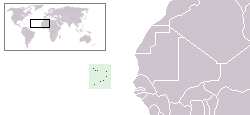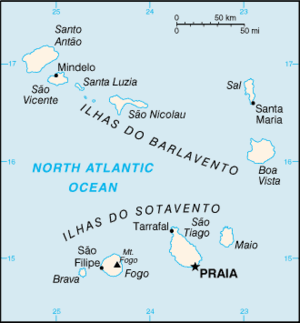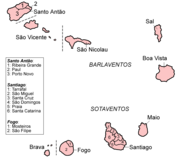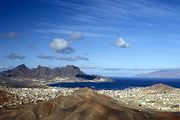Cape Verde
2007 Schools Wikipedia Selection. Related subjects: African Countries; Countries
| República de Cabo Verde Republic of Cape Verde |
|||||
|
|||||
| Anthem: Cântico da Liberdade | |||||
| Capital | Praia |
||||
|---|---|---|---|---|---|
| Largest city | Praia | ||||
| Official languages | Portuguese (official) and nine Portuguese Creoles |
||||
| Government | Republic | ||||
| - President | Pedro Pires | ||||
| - Prime Minister | José Maria Neves | ||||
| Independence | from Portugal | ||||
| - Recognized | July 5, 1975 | ||||
| Area | |||||
| - Total | 4,033 km² ( 172nd) 1,557 sq mi |
||||
| - Water (%) | negligible | ||||
| Population | |||||
| - July 2005 estimate | 507,000 ( 165th) | ||||
| - 2001 census | 401,343 | ||||
| - Density | 126/km² ( 79th) 326/sq mi |
||||
| GDP ( PPP) | 2005 estimate | ||||
| - Total | $3.055 billion ( 158th) | ||||
| - Per capita | $6,418 ( 92nd) | ||||
| HDI (2003) | 0.721 (medium) ( 105th) | ||||
| Currency | Cape Verdean escudo ( CVE) |
||||
| Time zone | CVT ( UTC-1) | ||||
| - Summer ( DST) | not observed ( UTC-1) | ||||
| Internet TLD | .cv | ||||
| Calling code | +238 | ||||
The Republic of Cape Verde or Cape Verde (Portuguese: Cabo Verde, pron. IPA: ['kabu 'veɾdɨ]) is a republic located on an archipelago in the Macaronesia ecoregion of the North Atlantic Ocean, off the western coast of Africa. The previously uninhabited islands were discovered and colonized by the Portuguese in the 15th century.
The country is named after Cap-Vert (meaning Green Cape), now in Senegal, the westernmost point of continental Africa.
History
Cape Verde was uninhabited when the Portuguese arrived in 1456 and made the islands part of the Portuguese empire. Due to its location off the coast of Africa, Cape Verde became an important watering station, then sugar cane plantation site, and later a major centre of the slave trade.
In 1975, the islands achieved independence, partly due to the efforts of the African Party for the Independence of Guinea-Bissau and Cape Verde ( PAIGC). After independence, the PAIGC attempted to unite Cape Verde and Guinea-Bissau into one nation, the PAIGC controlling both governments, but a coup in the latter nation in 1980 ended these plans. In Cape Verde itself the PAICV (affiliated with the PAIGC) governed until democratic elections, held in 1991, resulted in a change of government. The Movimento para a Democracia (MPD) won that election. The MPD was re-elected in 1996. The PAICV returned to power in 2001, and were re-elected in 2006.
Politics
Politics of Cape Verde takes place in a framework of a parliamentary representative democratic republic, whereby the Prime Minister of Cape Verde is the head of government, and of a pluriform multi-party system. Executive power is exercised by the government. Legislative power is vested in both the government and the National Assembly. The Judiciary is independent of the executive and the legislature.
Geography
Cape Verde is an archipelago off the west coast of Africa at 15.02N, 23.34W. It is formed by 10 main islands and about 8 islets. The main islands are:
- Barlaventos (northern island group)
- Santo Antão
- São Vicente
- Santa Luzia
- São Nicolau
- Sal
- Boa Vista
- Sotaventos (southern island group)
- Maio
- Santiago
- Fogo
- Brava
Of these, only Santa Luzia and the five islets are uninhabited. Presently it is a Natural Reserve. All islands are volcanic, but an active volcano only exists on one of the islands, Fogo (see Mount Fogo).
The islets are Branco, Razo.
Environment
The isolation of Cape Verde about 500 km from the African mainland has resulted in the islands having a large number of endemic species, many of which are endangered by human development. Endemic birds include Alexander's Swift (Apus alexandri), Raso Lark (Alauda razae), Cape Verde Warbler (Acrocephalus brevipennis), and Iago Sparrow (Passer iagoensis), and reptiles include the Cape Verde Giant Gecko (Tarentola gigas).
Climate
Cape Verde is in the tropical zone. Average temperatures range from 24°C (75°F) in January and February to 29°C (85°F) in September. The average annual rainfall for Cape Verde is 68.4 mm, with September the wettest month with 33.6 mm. Conversely, the months April to July record less than one millimetre of rainfall each.
Counties
Cape Verde is divided into seventeen counties (concelhos, singular concelho), sometimes referred to as municipalities (municípios, singular município), listed roughly clockwise:
- Santo Antão island:
- Paúl
- Porto Novo
- Ribeira Grande
- São Vicente
- Santa Luzia island (included in S. Vicente municipio)
- São Nicolau
- Sal
- Boa Vista
- Maio
- Santiago island:
- Praia
- Santa Catarina
- Santa Cruz
- São Domingos
- São Miguel
- Tarrafal
- Fogo island:
- São Filipe
- Mosteiros
- Brava
Economy
Cape Verde is a small nation that lacks resources and has experienced severe droughts. Agriculture is made difficult by lack of rain, and is restricted to only four islands for most of the year. Most of the nation's GDP comes from the service industry. Cape Verde's economy has grown since the late 1990s, and it is now considered a country of average development. Cape Verde has significant cooperation with Portugal at every level of the economy, leading it to link its currency first to the Portuguese escudo, and, in 1999, to the euro.
Former Portuguese prime minister José Manuel Durão Barroso, now (second semester 2004) president of the European Commission, has promised to help integrate Cape Verde within the European Union sphere of influence via greater cooperation with Portugal. In March 2005, former Portuguese president Mário Soares launched a petition urging the European Union to start membership talks with Cape Verde.
- Natural resources
salt, basalt rock, limestone, kaolin, fish, clay, gypsum.
Demographics
Most inhabitants of Cape Verde are mestiços, descendants of enslaved black Africans and white Portuguese settlers. Mestiços’ European ancestors also include Spanish and Italian seamen who were granted land by Portuguese Empire and followed by Portuguese settlers and exiles and Portuguese Jews who were victims of the Inquisition. The remainder includes mostly black Africans or Europeans (most Portuguese stepped out of the country after independence). Many foreigners from other parts of the world settled Cape Verde as their permanent country. Most of them were Dutch, French, British ( English), Arabs and Jews (from Lebanon and Morocco), Chinese (especially from Macau), Americans, and Brazilians (including people of Portuguese and African descent) settlers. All of these have been absorbed into the mestiço population.
More Cape Verdeans live abroad than in Cape Verde, with significant emigrant Cape Verdean communities in the United States (500,000 Cape Verdians), Portugal (80,000) and Angola (45,000). There are also significant number of Cape Verdeans in São Tomé and Príncipe, Senegal, France, Brazil and the Netherlands. Cape Verdean populations also settled Spain, Germany, and other CPLP countries (Brazil and Guinea-Bissau).
Culture
The culture of Cape Verde reflects its mixed African and Portuguese roots. It is well known for its diverse forms of music such as Morna (like the Portuguese Fado) and the urban Angolan kizomba, and a wide variety of dances: the soft dance Morna, and its modernized version, pasada, the Funana - a sensual mixed Portuguese and African dance, the extreme sensuality of coladeira (literally "glued"), and the African Batuque dance. These are reflective of the diverse origins of Cape Verde's residents. The term "Cabo" is used to refer to residents as well as the culture of Cape Verde.
Cape Verdean literature
Cape Verdean literature is one of the richest of Lusitanian Africa.
- Poets: Frusoni Sergio, Tavares Eugénio, B.Léza, João Cleofas Martins, Luís Romano de Madeira Melo, Ovídio Martins, Barbosa Jorge, Fortes Corsino António, Baltasar Lopes (Osvaldo Alcântara), João Vário, Oswaldo Osório, Arménio Vieira, Vadinho Velhinho, José Luís Tavares, etc.
- Authors: Manuel Lopes - Movimento Claridade, Almeida Germano, Luís Romano de Madeira Melo, Germano de Almeida, Orlanda Amarilis, Jorge Vera Cruz Barbosa, Pedro Cardoso, Mário José Domingues, Daniel Filipe, Mário Alberto Fonseca de Almeida, Corsino António Fortes, Arnaldo Carlos de Vasconcelos França, António Aurélio Gonçalves, Aguinaldo Brito Fonseca, Ovídio de Sousa Martins , Osvaldo Osório, Dulce Almada Duarte, Manuel Veiga
- Poems in Portuguese: Cape Verdean Poems, Poesia
- Cape Verdean Literature
- Sopinha de Alfabeto
- Famous tales: Ti Lobo and Chibinho
Music
- Música e Cabo-verdianos em Lisboa (Music portal)
- Composers
Eugénio Tavares, Francisco Xavier da Cruz (B.Leza), Adalberto "Betu" Silva, Carlos Alberto "Kaka" Barbosa, Ano Nobu, Renato Cardoso, Amandio Cabral, Paulino Vieira, Code di Dona, Daniel "Nhelas" Spencer, Orlando Pantera, Daniel Rendall, Luís Rendall, Manuel de Novas , Vasco Martins, Jorge Fernandes Monteiro ( Jotamont), Malamba Caçanhé, Frank Cavaquim (Francisco Vicente Gomes)
- Genres
Morna, Coladeira, Cola-Sanjon, Batuque, Funaná, Mazurca
Artists
Antoninho Travadinha, Antoni Denti D'Oro, Ana Firmino, Arlinda Santos, Bana, Bulimundo, Bius, Bau, Boss AC, Blick Tchutche, Codé di Dona, Cabo Verde Show, Cesária Évora, Celina Pereira, Cordas do Sol, Dany Silva, Suzanna Lubrano, Daniel Rendall, Dom Clifton aka DECYFA, Eddy Moreno, Frank Mimita, Fantcha, Fernando Quejas, Fortinho, Ildo Lobo, Jorge Humberto, Jacqueline Fortes, Jorge Neto, José Casimiro, João Cirilo, Luís Morais, Leonel Almeida, Livity, Lura, Maria-Alice, Mayra Andrade, Marinho Silva, Maria de Barros, Malaquias, Nancy Vieira, Nácia Gomi, Os Tubarões, Orlando Pantera, Paulino Vieira, Raiss di Funaná, Gé Mendes, Tcheka, Teofilo Chantre, Titina, Tututa, Tulipa Negra, Tito Paris, Tó Cruz, Sara Tavares, Simentera, Splash, Gil Semedo, Grace Évora, Gilyto, Voz de Cabo Verde, Voz d'África, Voginha, Xema Lopi, Zeca Nha Reinalda, Zézé Nha Reinalda, Kiki Lima
Language
Cape Verde's official language is Portuguese, and the language of instruction in official schools. However, the Cape Verdean Crioulo languages are also widely spoken. These are a range of Portuguese-based creole languages, which vary considerably from island to island.
There is a substantial body of literature in these languages, especially in the Crioulo of Santiago (badiu) and the Crioulo of São Vicente (criol d' Soncent). The Crioulo languages have been gaining prestige since the nation's independence from Portugal, and there is a movement to make the variant of Santiago the official language of the country.
However, the substantial differences between the languages spoken in different islands, each with its traditional spelling system, has been a major obstacle in the way of this move. Some people have advocated the development of two unformized official languages: a North (Barlavento) standard, centered on the Crioulo of San Vicente, and a South (Sotavento) standard, centered on that of Santiago.
Newspapers
- A Semana (Praia, since 1991)
- Espresso das Ilhas
- Jornal O Cidadao (São Vicente)
- Jornal Horizonte (Praia, since 1988)
- Terra Nova (S.Vicente, 1975-)
- Artiletra (S.Vicente, 1991-)
Online
- A Semana
- Infopress
- O Cidadao
- Paralelo 14
- Visão News
- O Liberal
- Espresso da Ilhas
- VozDiPovo-Online

















